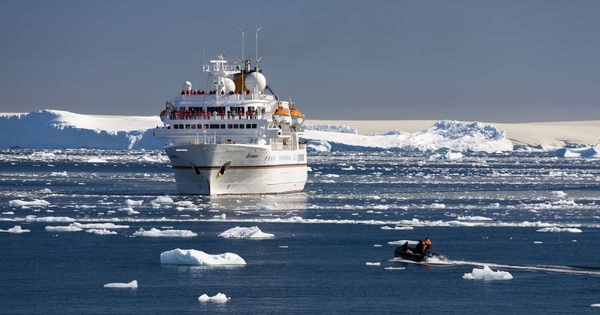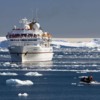Cruise lines sell the chance to see Arctic wildlife and claim they can do so without causing harm.
However, many Inuit and other indigenous people who have inhabited the Arctic for millennia are deeply worried.

Tourists buy souvenirs and bring income but also a growing threat of sewage and heavy fuel oil pollution as well as the disturbance and destruction of wildlife, such as ships striking whales in narrow channels.
Shrinking sea ice is allowing larger cruise ships to venture farther into the Arctic Circle to places previously only visited by specially adapted smaller vessels. The number of cruise passengers visiting the Arctic grew from 50,000 in 2005 to 80,000 in 2016 and some cruise companies are forecasting 40 per cent growth by 2020.
Now MPs are calling for cruise ships carrying more than 500 people to be banned from the Arctic. Ships of that size are already banned from conducting any landings in the Antarctic.
The environmental audit committee heard evidence that very large cruise ships with up to 6,000 passengers were “docking in small Arctic communities and overwhelming them”. It wants the government to use its observer status on the Arctic Council to press for a ban by the members with territorial claims over the region: Canada, Denmark, Finland, Iceland, Norway, Russia, Sweden and the United States.
The committee concluded: “There is a risk that the thousands of tourists who travel to see a pristine, remote and unspoilt Arctic landscape are contributing to degradation of the very environment they came to see, and increased tourism can disrupt traditional ways of life.”
Residents of Nunavut in the Canadian Arctic complained last year that cruise ships were disturbing whales and nesting seabirds and undermining the Inuit way of life.
A leading member of the council of Pond Inlet on the northern tip of Baffin Island, told a hearing on Arctic development: “The cruise ships are disturbing many wildlife as they travel. We have stressed that cruise ships be restricted, but there is no response from anybody. They come and go as they please. This is regrettable and unfortunate. We have no voice.”
The professor of climate change adaptation at the University of Leeds, said that cruise ships could bring commercial benefits to Arctic ports but they also overwhelmed them.
He said that the cruise industry was promoting “last chance tourism” to see glaciers before they melted and wildlife before it disappeared, but the Arctic was not ready to accommodate the increase in visitors.
Cruise passengers could also be at risk because there was “very little capability to respond to a mass casualty incident in the Arctic”.
Typical cruise passengers are oblivious to the jeopardy their tourism is causing - focussed mainly witht the onboard luxury service, endless food and dazzling entertainment it is rare for them to explore the wider concerns of the habitats they sail through.
Cruise Ship Entertainment provides a convenient diversion to the concerns - image credit: Entertainers Worldwide
“It’s mostly local communities who would have to send out a rescue party and they only have small boats. Getting a Hercules plane there would take seven to eight hours,” he said. The Association of Arctic Expedition Cruise Operators said that the size of ship was not a problem as long as visits were well managed. Carnival UK, which next summer will send two cruise ships into the Arctic — the Queen Elizabeth to Anchorage and the Oriana to Svalbard — said that it used less polluting marine gasoil in the Arctic.
Tim Soper, a polar travel expert who oversaw the first voyage through the Northwest Passage by a large cruise ship in 2016, said the 1,000 passengers on the Crystal Serenity had been taken ashore to Arctic villages up to 200 at a time to avoid overwhelming them. He said that the passengers, who had paid between £15,000 and £80,000 per person for the 32-day voyage, were asked not to use mobile phones to avoid clogging local networks and avoid emptying local shops of essential goods that might not be restocked for a year.
Kelvin Murray, a colleague of Mr Soper at Eyos Expeditions, said that cruise ships accounted for a very small proportion of large vessels visiting the Arctic and there were many more tankers and ore transporters.
He said the Arctic required careful, considered protection but added that the majority of visitors “walk away as an ambassador for these places”.



